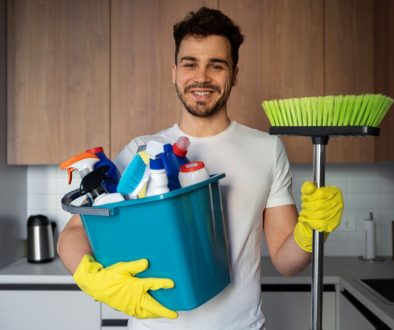Cleaning vs. Disinfecting: Understanding the Key Differences
Maintaining a clean and safe workplace is crucial for health and well-being. Understanding the difference between cleaning and disinfecting ensures that offices and workspaces are not only visually clean but also free from harmful germs. For comprehensive results, many businesses depends on commercial cleaning services. Let’s dive into what these processes entail and why both are essential.
On This Page
Definitions and Purposes
Cleaning:
Disinfecting:
Importance of Both Processes
Both cleaning and disinfecting are essential for maintaining health and safety. According to the Centers for Disease Control and Prevention (CDC), cleaning surfaces with soap and water reduces the number of germs, dirt, and impurities on the surface, while disinfecting kills the germs on the surface. This dual approach is crucial in environments like offices, where preventing the spread of infections is vital.
Differences Between Cleaning and Disinfecting
What Cleaning Removes: Cleaning targets visible dirt, dust, food residues, and other physical impurities. It’s about achieving visual cleanliness. For instance, wiping a desk with soap and water removes crumbs and grease but might not kill all the bacteria lurking on the surface.
What Disinfecting Accomplishes: Disinfecting goes beyond what the eye can see. It targets and kills germs that could cause illness. For example, using a bleach solution on the same desk after cleaning will kill the bacteria and viruses present, making it safer for use.
Examples of When to Clean vs. Disinfect:
Best Practices for Cleaning
Effective Cleaning Techniques:
- Dusting: Use microfiber cloths to capture dust effectively and prevent it from being redistributed into the air.
- Vacuuming: Regularly cleaning upholstery to remove rugs dirt and debris that can accumulate and affect air quality.
- Scrubbing: Use appropriate brushes and sponges for scrubbing sinks, tubs, and tiles to remove built-up grime and soap scum.
Choosing the Right Cleaning Products:
Cleaning High-Touch Surfaces:
Best Practices for Disinfecting
Effective Disinfecting Methods:
- Pre-Cleaning: Clean the surface first if it is visibly dirty, as dirt can inhibit the effectiveness of disinfectants.
- Apply Disinfectant: Use a disinfectant that is effective against a broad spectrum of germs, following the product’s instructions for proper application.
- Contact Time: Ensure the disinfectant remains wet on the surface for the recommended contact time, usually between 30 seconds to 10 minutes, to effectively kill germs.
Choosing the Right Disinfecting Agents:
Frequency of Disinfecting:
Safety Tips
Handling Chemicals Safely:
Protecting Vulnerable Individuals:
Maintaining Good Ventilation:
Common Misconceptions
Cleaning Equals Disinfecting:
Over-Disinfecting:
Conclusion
Understanding the differences between cleaning and disinfecting is crucial for maintaining a healthy environment. Implementing both processes appropriately can help reduce the risk of illness and create a more pleasant working space.
Get in touch
Need expert cleaning or disinfecting services? Contact us to ensure your workplace is both clean and safe. Our professional team is equipped with the knowledge and tools to handle all your cleaning and disinfecting needs, providing peace of mind and a healthier environment for you and your colleagues.
Call Us: +353 8729 68828
Email: info@webappprojects.online






